STS-107: Columbia down
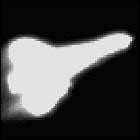 After nearly 17 days in orbit performing experiments in the SPACEHAB module its cargo bay, Space Shuttle Columbia deorbits to return to Earth for a planned landing at Kennedy Space Center in Florida. During reentry, a gaping hole in the leading edge of Columbia’s left wing – damage caused by a piece of foam shaken loose from the external fuel tank during liftoff – allows superheated plasma to leak into the shuttle’s superstructure, tearing the vehicle apart. The entire crew (Commander Rick Husband, Pilot Willie McCool, Payload Commander Michael Anderson, mission specialists Kalpana Chawla, David Brown and Laurel Clark, and payload specialist Ilan Ramon) is lost. At first, ground controllers are only aware of a series of sensor failures in the wing, followed by a loss of contact; ground-based cameras finally spot an expanding cloud of debris falling at supersonic speeds. As with the loss of Challenger in 1986, an extensive investigation and review of NASA procedures follows the loss of Columbia and her crew, resulting in a two-year grounding of the remaining shuttle fleet and a pause in construction of the International Space Station.
After nearly 17 days in orbit performing experiments in the SPACEHAB module its cargo bay, Space Shuttle Columbia deorbits to return to Earth for a planned landing at Kennedy Space Center in Florida. During reentry, a gaping hole in the leading edge of Columbia’s left wing – damage caused by a piece of foam shaken loose from the external fuel tank during liftoff – allows superheated plasma to leak into the shuttle’s superstructure, tearing the vehicle apart. The entire crew (Commander Rick Husband, Pilot Willie McCool, Payload Commander Michael Anderson, mission specialists Kalpana Chawla, David Brown and Laurel Clark, and payload specialist Ilan Ramon) is lost. At first, ground controllers are only aware of a series of sensor failures in the wing, followed by a loss of contact; ground-based cameras finally spot an expanding cloud of debris falling at supersonic speeds. As with the loss of Challenger in 1986, an extensive investigation and review of NASA procedures follows the loss of Columbia and her crew, resulting in a two-year grounding of the remaining shuttle fleet and a pause in construction of the International Space Station.
STS-107
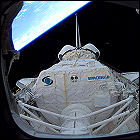 Space Shuttle Columbia lifts off for a scientific research mission with the SPACEHAB module – a successor to Spacelab – in its cargo bay, for a flight lasting almost 17 days. Columbia’s crew for this flight is Commander Rick Husband, Pilot Willie McCool, Payload Commander Michael Anderson, mission specialists Kalpana Chawla, David Brown and Laurel Clark, and payload specialist Ilan Ramon, the first Israeli astronaut. During liftoff, a piece of insulated foam is vibrated loose from the shuttle’s external fuel tank, causing critical damage to the leading edge of Columbia’s left wing. The foam collision is noticed and discussed internally at NASA, but is not deemed a threat by ground controllers.
Space Shuttle Columbia lifts off for a scientific research mission with the SPACEHAB module – a successor to Spacelab – in its cargo bay, for a flight lasting almost 17 days. Columbia’s crew for this flight is Commander Rick Husband, Pilot Willie McCool, Payload Commander Michael Anderson, mission specialists Kalpana Chawla, David Brown and Laurel Clark, and payload specialist Ilan Ramon, the first Israeli astronaut. During liftoff, a piece of insulated foam is vibrated loose from the shuttle’s external fuel tank, causing critical damage to the leading edge of Columbia’s left wing. The foam collision is noticed and discussed internally at NASA, but is not deemed a threat by ground controllers.
STS-109: Hubble’s new wings
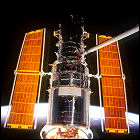 Space Shuttle Columbia lifts off on the 108th shuttle flight, the third Hubble Space Telescope servicing mission. Numerous enhancements are carried aboard the shuttle to replace existing parts on the decade-old orbiting telescope, including new cooling systems and a new set of solar power arrays. Aboard Columbia for her 27th flight are Commander Scott Altman, Pilot Duane Carey, Payload Commander John Grunsfeld, and mission specialists Nancy Currie, James Newman, Richard Linnehan and Michael Massimino.
Space Shuttle Columbia lifts off on the 108th shuttle flight, the third Hubble Space Telescope servicing mission. Numerous enhancements are carried aboard the shuttle to replace existing parts on the decade-old orbiting telescope, including new cooling systems and a new set of solar power arrays. Aboard Columbia for her 27th flight are Commander Scott Altman, Pilot Duane Carey, Payload Commander John Grunsfeld, and mission specialists Nancy Currie, James Newman, Richard Linnehan and Michael Massimino.
Space Shuttle Columbia makes her final landing at the end of this 11-day mission.
STS-93
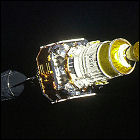 Space Shuttle Columbia lifts off on a five-day mission to deploy the Chanda X-Ray Observatory satellite. The first American space mission with a woman in the commander’s seat, this flight also includes some ultraviolet astronomy experiments, and sees the first test of HDTV equipment in space. Aboard Columbia for her 26th mission are Commander Eileen Collins, Pilot Jeff Ashby, and mission specialists Steven Hawley, Catherine Coleman and Michel Tognini. After landing, Columbia is removed from the orbiter rotation with the intention of permanent retirement, though a demanding launch schedule convinces NASA to upgrade Columbia and return the flagship of the shuttle fleet to service in 2002.
Space Shuttle Columbia lifts off on a five-day mission to deploy the Chanda X-Ray Observatory satellite. The first American space mission with a woman in the commander’s seat, this flight also includes some ultraviolet astronomy experiments, and sees the first test of HDTV equipment in space. Aboard Columbia for her 26th mission are Commander Eileen Collins, Pilot Jeff Ashby, and mission specialists Steven Hawley, Catherine Coleman and Michel Tognini. After landing, Columbia is removed from the orbiter rotation with the intention of permanent retirement, though a demanding launch schedule convinces NASA to upgrade Columbia and return the flagship of the shuttle fleet to service in 2002.
STS-90
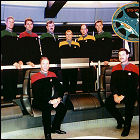 NASA launches Space Shuttle Columbia on the 90th shuttle mission, in which 16 days are spent in orbit conducting studies of the human nervous system in a weightless environment. This is the final flight of the 20-year-old Spacelab module aboard a space shuttle, though some elements of Spacelab are later incorporated into the International Space Station. Columbia’s 25th crew is Commander Richard Searfoss, Pilot Scott Altman, and mission specialists Richard Linnehan, Dafydd Rhys Williams and Kathryn Hire, and payload specialists Dr. Jay Buckey and Dr. James Pawelczyk. (The crew, along with backup crewmembers, is pictured here during a visit to the set of Star Trek: Voyager.)
NASA launches Space Shuttle Columbia on the 90th shuttle mission, in which 16 days are spent in orbit conducting studies of the human nervous system in a weightless environment. This is the final flight of the 20-year-old Spacelab module aboard a space shuttle, though some elements of Spacelab are later incorporated into the International Space Station. Columbia’s 25th crew is Commander Richard Searfoss, Pilot Scott Altman, and mission specialists Richard Linnehan, Dafydd Rhys Williams and Kathryn Hire, and payload specialists Dr. Jay Buckey and Dr. James Pawelczyk. (The crew, along with backup crewmembers, is pictured here during a visit to the set of Star Trek: Voyager.)
STS-87
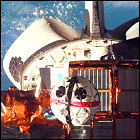 Space Shuttle Columbia lifts off on the 88th shuttle flight, a mission lasting nearly 16 days to conduct microgravity studies and deploy a space science payload which begins spinning after the shuttle’s manipulator arm releases it. Plans to match the shuttle to the satellite’s rotation and recapture it are called off in favor of a no-less-risky seven-hour, two-man spacewalk to slow the satellite’s rotation and retrieve it. Aboard Columbia for her 24th flight are Commander Kevin Kregel, Pilot Steven Lindsey, and mission specialists Winston Scott, Kalpana Chawla, Takao Doi and Leonid Kadenyuk.
Space Shuttle Columbia lifts off on the 88th shuttle flight, a mission lasting nearly 16 days to conduct microgravity studies and deploy a space science payload which begins spinning after the shuttle’s manipulator arm releases it. Plans to match the shuttle to the satellite’s rotation and recapture it are called off in favor of a no-less-risky seven-hour, two-man spacewalk to slow the satellite’s rotation and retrieve it. Aboard Columbia for her 24th flight are Commander Kevin Kregel, Pilot Steven Lindsey, and mission specialists Winston Scott, Kalpana Chawla, Takao Doi and Leonid Kadenyuk.
STS-94: do-over in space
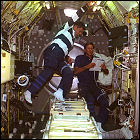 For the first and only time in the history of the American space program, a previously aborted mission is flown with the same vehicle, cargo and crew. Space Shuttle Columbia returns to orbit with Spacelab in its cargo bay for an attempt to fully carry out the aborted STS-83 mission, which was recalled to Earth in April. This time, the mission is successful, with nearly 16 days of microgravity experiments carried out by the crew. Flying Columbia – again – are Commander James Halsell, Pilot Susan Still, Payload Commander Janice Voss, mission specialists Donald Thomas and Michael Gernhardt, and payload specialists Roger Crouch and Greg Linteris.
For the first and only time in the history of the American space program, a previously aborted mission is flown with the same vehicle, cargo and crew. Space Shuttle Columbia returns to orbit with Spacelab in its cargo bay for an attempt to fully carry out the aborted STS-83 mission, which was recalled to Earth in April. This time, the mission is successful, with nearly 16 days of microgravity experiments carried out by the crew. Flying Columbia – again – are Commander James Halsell, Pilot Susan Still, Payload Commander Janice Voss, mission specialists Donald Thomas and Michael Gernhardt, and payload specialists Roger Crouch and Greg Linteris.
STS-83: recalled to Earth
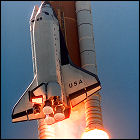 Space Shuttle Columbia is launched on the 83rd shuttle mission, intended to last over two weeks. In the cargo bay, the Spacelab module is set up for an intensive study of the behavior of natural processes in microgravity. A recurring issue with one of the shuttle’s three fuel cells concerns ground controllers enough to recall Columbia to Earth after only 63 orbits, only the third time a shuttle mission has been cut short. Aboard Columbia for her 22nd flight are Commander James Halsell, Pilot Susan Still, Payload Commander Janice Voss, mission specialists Donald Thomas and Michael Gernhardt, and payload specialists Roger Crouch and Greg Linteris. A reflight of the Spacelab mission is scheduled for the upcoming STS-94 mission in July.
Space Shuttle Columbia is launched on the 83rd shuttle mission, intended to last over two weeks. In the cargo bay, the Spacelab module is set up for an intensive study of the behavior of natural processes in microgravity. A recurring issue with one of the shuttle’s three fuel cells concerns ground controllers enough to recall Columbia to Earth after only 63 orbits, only the third time a shuttle mission has been cut short. Aboard Columbia for her 22nd flight are Commander James Halsell, Pilot Susan Still, Payload Commander Janice Voss, mission specialists Donald Thomas and Michael Gernhardt, and payload specialists Roger Crouch and Greg Linteris. A reflight of the Spacelab mission is scheduled for the upcoming STS-94 mission in July.
STS-80
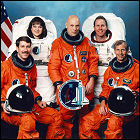 Space Shuttle Columbia lifts off on the 80th shuttle flight, a science mission lasting nearly 18 days. Two free-floating experiment platforms are deployed and then retrieved by the end of the mission for delivery back to Earth. Two spacewalks to test space station construction techniques are called off for safety reasons when a problem arises with Columbia’s airlock. Aboard Columbia for her 21st flight are Commander Kenneth Cockrell, Pilot Kent Rominger, and mission specialists Tammy Jernigan, Thomas Jones and Story Musgrave.
Space Shuttle Columbia lifts off on the 80th shuttle flight, a science mission lasting nearly 18 days. Two free-floating experiment platforms are deployed and then retrieved by the end of the mission for delivery back to Earth. Two spacewalks to test space station construction techniques are called off for safety reasons when a problem arises with Columbia’s airlock. Aboard Columbia for her 21st flight are Commander Kenneth Cockrell, Pilot Kent Rominger, and mission specialists Tammy Jernigan, Thomas Jones and Story Musgrave.
STS-78
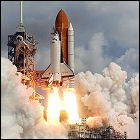 Space Shuttle Columbia lifts off on the 78th shuttle mission, a Spacelab flight lasting nearly 17 days and devoted to the effects of microgravity on various forms of life. The crew also tests maneuvers under consideration for a future Hubble Space Telescope servicing mission which could safely boost Hubble’s orbit without damaging it. Aboard Columbia for her 20th flight are Commander Terence Henricks, Pilot Kevin Kregel, flight engineer Susan Helms, mission specialists Richard Linnehan and Charles Brady, and payload specialists Jean-Jacques Favier and Robert Thirsk.
Space Shuttle Columbia lifts off on the 78th shuttle mission, a Spacelab flight lasting nearly 17 days and devoted to the effects of microgravity on various forms of life. The crew also tests maneuvers under consideration for a future Hubble Space Telescope servicing mission which could safely boost Hubble’s orbit without damaging it. Aboard Columbia for her 20th flight are Commander Terence Henricks, Pilot Kevin Kregel, flight engineer Susan Helms, mission specialists Richard Linnehan and Charles Brady, and payload specialists Jean-Jacques Favier and Robert Thirsk.
STS-75
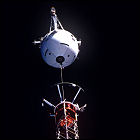 Space Shuttle Columbia is launched on the 75th shuttle flight, staying in orbit for nearly 16 days. The crew attempts to deploy a tethered satellite experiment flown unsuccessfully in 1992, only to watch as the tether snaps with the satellite 12 miles away from the shuttle. The remainder of the flight is spent conducting planned material science experiments. Aboard Columbia for her 19th flight are Commander Andrew Allen, Pilot Scott Horowitz, Payload Commander Franklin Chang-Diaz, and mission specialists Maurizio Cheli, Jeffrey Hoffman, Claude Nicollier and Umberto Guidoni. To this day, video of the satellite floating in space after the tether failure is circulated as “proof” of the existence of UFOs.
Space Shuttle Columbia is launched on the 75th shuttle flight, staying in orbit for nearly 16 days. The crew attempts to deploy a tethered satellite experiment flown unsuccessfully in 1992, only to watch as the tether snaps with the satellite 12 miles away from the shuttle. The remainder of the flight is spent conducting planned material science experiments. Aboard Columbia for her 19th flight are Commander Andrew Allen, Pilot Scott Horowitz, Payload Commander Franklin Chang-Diaz, and mission specialists Maurizio Cheli, Jeffrey Hoffman, Claude Nicollier and Umberto Guidoni. To this day, video of the satellite floating in space after the tether failure is circulated as “proof” of the existence of UFOs.
STS-73
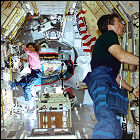 Space Shuttle Columbia is launched on the 72nd shuttle mission, and Columbia’s 18th visit to Earth orbit. Over a 16-day period, the Spacelab module mounted in the cargo bay hosts the second U.S. Microgravity Laboratory mission, with experiments conducted around the clock. The first pitch of the fifth game of the 1995 World Series is thrown aboard Columbia and broadcast live – the first time that the first pitch of a game took place somewhere other than the ballpark in question. Columbia is manned by Commander Kenneth Bowersox, Pilot Kent Rominger, Payload Commander Kathryn Thornton, mission specialists Catherine Coleman and Michael Lopez-Alegria, and payload specialists Fred Leslie and Albert Sacco.
Space Shuttle Columbia is launched on the 72nd shuttle mission, and Columbia’s 18th visit to Earth orbit. Over a 16-day period, the Spacelab module mounted in the cargo bay hosts the second U.S. Microgravity Laboratory mission, with experiments conducted around the clock. The first pitch of the fifth game of the 1995 World Series is thrown aboard Columbia and broadcast live – the first time that the first pitch of a game took place somewhere other than the ballpark in question. Columbia is manned by Commander Kenneth Bowersox, Pilot Kent Rominger, Payload Commander Kathryn Thornton, mission specialists Catherine Coleman and Michael Lopez-Alegria, and payload specialists Fred Leslie and Albert Sacco.
STS-65
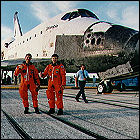 Space Shuttle Columbia is launched on the 63rd mission of the shuttle program. For two weeks, Columbia’s crew participates in the second IML (International Microgravity Laboratory) flight, conducting experiments relying on zero G around the clock. Columbia is also in orbit during the 25th anniversary of Apollo 11, the moon landing mission whose command/service module was also named Columbia. Aboard for Columbia’s 17th flight are Commander Robert Cabana, Pilot James Halsell, Payload Commander Richard Hieb, mission specialists Carl Walz, Leroy Chiao and Donald Thomas, and payload specialist Chiaki Naito-Mukai, the first Japanese woman in space.
Space Shuttle Columbia is launched on the 63rd mission of the shuttle program. For two weeks, Columbia’s crew participates in the second IML (International Microgravity Laboratory) flight, conducting experiments relying on zero G around the clock. Columbia is also in orbit during the 25th anniversary of Apollo 11, the moon landing mission whose command/service module was also named Columbia. Aboard for Columbia’s 17th flight are Commander Robert Cabana, Pilot James Halsell, Payload Commander Richard Hieb, mission specialists Carl Walz, Leroy Chiao and Donald Thomas, and payload specialist Chiaki Naito-Mukai, the first Japanese woman in space.
STS-62
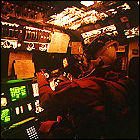 Space Shuttle Columbia lifts off on the 61st shuttle mission, a two-week visit to Earth orbit carrying two cargo-bay-mounted experiment systems operated primarily from the ground. Crew members participate in experiments involving the side-effects of long-term space travel. The crew for Columbia’s 16th flight consists of Commander John Casper, Pilot Andrew Allen, and mission specialists Pierre Thuot, Charles Gemar and Marsha Ivins.
Space Shuttle Columbia lifts off on the 61st shuttle mission, a two-week visit to Earth orbit carrying two cargo-bay-mounted experiment systems operated primarily from the ground. Crew members participate in experiments involving the side-effects of long-term space travel. The crew for Columbia’s 16th flight consists of Commander John Casper, Pilot Andrew Allen, and mission specialists Pierre Thuot, Charles Gemar and Marsha Ivins.
STS-58
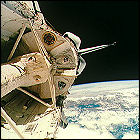 Space Shuttle Columbia is launched on the 58th shuttle mission, a two-week stay in orbit with the Spacelab module. This is the second Spacelab flight devoted to medical experiments and life sciences. Aboard Columbia for her 15th flight are Commander John Blaha, Pilot Richard Searfoss, mission specialists Rhea Seddon, William McArthur, David Wolf and Shannon Lucid, and payload specialist Martin Fettman.
Space Shuttle Columbia is launched on the 58th shuttle mission, a two-week stay in orbit with the Spacelab module. This is the second Spacelab flight devoted to medical experiments and life sciences. Aboard Columbia for her 15th flight are Commander John Blaha, Pilot Richard Searfoss, mission specialists Rhea Seddon, William McArthur, David Wolf and Shannon Lucid, and payload specialist Martin Fettman.
STS-55
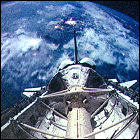 Space Shuttle Columbia lifts off on a mission lasting nearly ten days, carrying the Spacelab laboratory module in its cargo bay. This flight, Spacelab D-2, includes medical and material experiments, with one experiment controlled by an Apple Macintosh computer carried into orbit. Amateur radio messages are exchanged with the crew of the Mir space station. Aboard Columbia for her 14th flight are Commander Steven Nagel, Pilot Terence Henricks, mission specialists Jerry Ross, Charles Precourt and Bernard Harris Jr., and payload specialists Ulrich Walter and Hans Schlegel.
Space Shuttle Columbia lifts off on a mission lasting nearly ten days, carrying the Spacelab laboratory module in its cargo bay. This flight, Spacelab D-2, includes medical and material experiments, with one experiment controlled by an Apple Macintosh computer carried into orbit. Amateur radio messages are exchanged with the crew of the Mir space station. Aboard Columbia for her 14th flight are Commander Steven Nagel, Pilot Terence Henricks, mission specialists Jerry Ross, Charles Precourt and Bernard Harris Jr., and payload specialists Ulrich Walter and Hans Schlegel.
STS-52
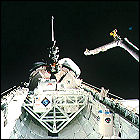 Space Shuttle Columbia lifts off on the shuttle program’s 51st flight, a ten-day mission to launch Laser Geodynamic Satellite II and the cargo-bay-mounted U.S. Microgravity Payload experiment package. Aboard Columbia for her 13th flight are Commander James Wetherbee, Pilot Michael Baker, mission specialists Charles Veach, William Shepherd and Tamara Jernigan, and payload specialist Steven MacLean.
Space Shuttle Columbia lifts off on the shuttle program’s 51st flight, a ten-day mission to launch Laser Geodynamic Satellite II and the cargo-bay-mounted U.S. Microgravity Payload experiment package. Aboard Columbia for her 13th flight are Commander James Wetherbee, Pilot Michael Baker, mission specialists Charles Veach, William Shepherd and Tamara Jernigan, and payload specialist Steven MacLean.
STS-50
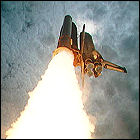 NASA launches Space Shuttle Columbia on the 48th shuttle mission (Columbia’s 12th trip into orbit). Using the Spacelab module, Columbia’s crew conducted the first USML (United States Microgravity Laboratory) flight, as well as testing a new system called the EDO (Extended Duration Orbiter) package, allowing the crew to stay in orbit longer than any previous shuttle (or, for that matter, lunar) flight. Aboard Columbia for the record-breaking 13-and-a-half-day mission are Commander Richard N. Richards, Pilot Ken Bowersox, Payload Commander Bonnie Dunbar, mission specialists Ellen Baker and Carl Meade, and payload specialists Lawrence DeLucasand Eugene Trinh.
NASA launches Space Shuttle Columbia on the 48th shuttle mission (Columbia’s 12th trip into orbit). Using the Spacelab module, Columbia’s crew conducted the first USML (United States Microgravity Laboratory) flight, as well as testing a new system called the EDO (Extended Duration Orbiter) package, allowing the crew to stay in orbit longer than any previous shuttle (or, for that matter, lunar) flight. Aboard Columbia for the record-breaking 13-and-a-half-day mission are Commander Richard N. Richards, Pilot Ken Bowersox, Payload Commander Bonnie Dunbar, mission specialists Ellen Baker and Carl Meade, and payload specialists Lawrence DeLucasand Eugene Trinh.
STS-40
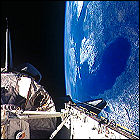 Space Shuttle Columbia lifts off on a nine-day mission with – for the first time in the shuttle program – a crew that’s nearly 50% female. Columbia carries the Spacelab module into orbit for a series of life sciences and biology experiments, the first flight devoted to such experiments since the Skylab era. Aboard Columbia for this flight are Commander Bryan O’Connor, Pilot Sidney Gutierrez, and mission specialists James Bagian, Tamara Jernigan, Rhea Seddon, Drew Gaffney and Millie Hughes-Fulford.
Space Shuttle Columbia lifts off on a nine-day mission with – for the first time in the shuttle program – a crew that’s nearly 50% female. Columbia carries the Spacelab module into orbit for a series of life sciences and biology experiments, the first flight devoted to such experiments since the Skylab era. Aboard Columbia for this flight are Commander Bryan O’Connor, Pilot Sidney Gutierrez, and mission specialists James Bagian, Tamara Jernigan, Rhea Seddon, Drew Gaffney and Millie Hughes-Fulford.
STS-35
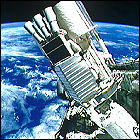 Space Shuttle Columbia lifts off for an eight-day mission to become a manned space telescope in Earth orbit, carrying the ASTRO-1 package designed to conduct X-ray and ultraviolet astronomy, mounted on an unmanned Spacelab pallet in the cargo bay. The mission has been delayed for months, most notably by hydrogen leaks detected long before the original May launch date. Manning Columbia for this flight are Commander Vance Brand, Pilot Guy Gardner, mission specialists Jeffrey Hoffman, John Lounge and Robert Parker, and payload specialists Samuel Durrance and Ronald Parise.
Space Shuttle Columbia lifts off for an eight-day mission to become a manned space telescope in Earth orbit, carrying the ASTRO-1 package designed to conduct X-ray and ultraviolet astronomy, mounted on an unmanned Spacelab pallet in the cargo bay. The mission has been delayed for months, most notably by hydrogen leaks detected long before the original May launch date. Manning Columbia for this flight are Commander Vance Brand, Pilot Guy Gardner, mission specialists Jeffrey Hoffman, John Lounge and Robert Parker, and payload specialists Samuel Durrance and Ronald Parise.
STS-32
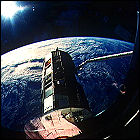 Space Shuttle Columbia lifts off on a ten-day mission to deploy the LEASAT 5 communications satellite and retrieve the Long Duration Exposure Facility satellite that had been placed in orbit in 1984 by Challenger. (LDEF retrieval, delayed from 1985, had been put off by several additional years by the Challenger accident and its aftermath.) Aboard Columbia in this flight are Commander Daniel Brandenstein, Pilot James Wetherbee, and mission specialists Bonnie Dunbar, G. David Low, and Marsha Ivins.
Space Shuttle Columbia lifts off on a ten-day mission to deploy the LEASAT 5 communications satellite and retrieve the Long Duration Exposure Facility satellite that had been placed in orbit in 1984 by Challenger. (LDEF retrieval, delayed from 1985, had been put off by several additional years by the Challenger accident and its aftermath.) Aboard Columbia in this flight are Commander Daniel Brandenstein, Pilot James Wetherbee, and mission specialists Bonnie Dunbar, G. David Low, and Marsha Ivins.
STS-28
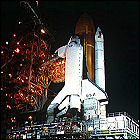 Lifting off on its first spaceflight since January 1986, Space Shuttle Columbia heads into orbit on a five-day classified Department of Defense mission. Columbia’s crew for this flight consists of Commander Brewster Shaw, Pilot Richard Richards, and mission specialists James Adamson, David Leestma and Mark Brown.
Lifting off on its first spaceflight since January 1986, Space Shuttle Columbia heads into orbit on a five-day classified Department of Defense mission. Columbia’s crew for this flight consists of Commander Brewster Shaw, Pilot Richard Richards, and mission specialists James Adamson, David Leestma and Mark Brown.
STS-61C
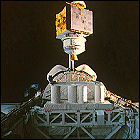 Space Shuttle Columbia lifts off on a six-day satellite deployment mission, and is also the first spaceflight to include a sitting member of the US Congress among its crew. The SATCOM KU-I satellite is launched, but another payload designed to observe Halley’s Comet (which is rapidly approaching its closest approach to Earth) malfunctions and collects no data. Columbia’s crew for this mission consists of Commander Robert Gibson, Pilot Charles Bolden, mission specialists Franklin Chang-Diaz, Steven Hawley, George Nelson, and payload specialists Robert Cenker and Congressman Bill Nelson.
Space Shuttle Columbia lifts off on a six-day satellite deployment mission, and is also the first spaceflight to include a sitting member of the US Congress among its crew. The SATCOM KU-I satellite is launched, but another payload designed to observe Halley’s Comet (which is rapidly approaching its closest approach to Earth) malfunctions and collects no data. Columbia’s crew for this mission consists of Commander Robert Gibson, Pilot Charles Bolden, mission specialists Franklin Chang-Diaz, Steven Hawley, George Nelson, and payload specialists Robert Cenker and Congressman Bill Nelson.
This is the final successful shuttle flight until 1988.
STS-9
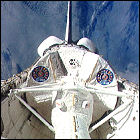 Returning to space after nearly a year of refits, Space Shuttle Columbia lifts off on the long-delayed first manned mission of the Spacelab laboratory module, which is installed in the cargo bay. (The nearly month-long delay was the result of a solid rocket booster issue that led to the first-ever return of the shuttle from the launch pad to the Vehicle Assembly Building.) The ten-day mission also boasts the first six-person shuttle crew, featuring the first Spacelab scientists from the European Space Agency, who have been training for this mission since the 1970s. Columbia’s crew includes Commander John Young, Pilot Brewster Shaw, mission specialists Owen Garriott and Robert Parker, and ESA payload specialists Byron Lichtenberg and Ulf Merbold.
Returning to space after nearly a year of refits, Space Shuttle Columbia lifts off on the long-delayed first manned mission of the Spacelab laboratory module, which is installed in the cargo bay. (The nearly month-long delay was the result of a solid rocket booster issue that led to the first-ever return of the shuttle from the launch pad to the Vehicle Assembly Building.) The ten-day mission also boasts the first six-person shuttle crew, featuring the first Spacelab scientists from the European Space Agency, who have been training for this mission since the 1970s. Columbia’s crew includes Commander John Young, Pilot Brewster Shaw, mission specialists Owen Garriott and Robert Parker, and ESA payload specialists Byron Lichtenberg and Ulf Merbold.
STS-5
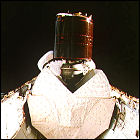 On the first fully-operational flight of NASA’s Space Transportation System, Space Shuttle Columbia delivers two commercial satellites to orbit, the Canadian Anik C-3 satellite and an American satellite, SitS-C. Aboard Columbia for this flight is the first four-astronaut crew in NASA’s history, consisting of Commander Vance Brand, Pilot Robert Overmyer, and mission specialists Joseph Allen and William Lenoir. The flight lasts five days before a landing at Edwards Air Force Base.
On the first fully-operational flight of NASA’s Space Transportation System, Space Shuttle Columbia delivers two commercial satellites to orbit, the Canadian Anik C-3 satellite and an American satellite, SitS-C. Aboard Columbia for this flight is the first four-astronaut crew in NASA’s history, consisting of Commander Vance Brand, Pilot Robert Overmyer, and mission specialists Joseph Allen and William Lenoir. The flight lasts five days before a landing at Edwards Air Force Base.
“The test flights are over”
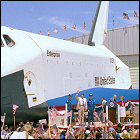 Space Shuttle Columbia lands at Edwards Air Force Base in California, making its first-ever landing on a concrete runway. After greeting the returning astronauts and inspecting the shuttle, President Ronald Reagan – with the partially-dismantled prototype Enterprise as a backdrop – declares NASA’s Space Shuttle system fully operational, saying “the test flights are over.” Columbia Commander Ken Mattingly later reveals that there was tremendous pressure on NASA to land Columbia on Independence Day, regardless of how many mission objectives had been met, to maximize the publicity value of the President’s speech. But the quick turnaround time and almost-weekly flight schedule that NASA had publicized throughout the 1970s is already a pipe dream: post-mission the four missions flown so far prove that post-landing servicing of each orbiter takes longer than expected. Columbia won’t fly again until the first “operational” mission in November.
Space Shuttle Columbia lands at Edwards Air Force Base in California, making its first-ever landing on a concrete runway. After greeting the returning astronauts and inspecting the shuttle, President Ronald Reagan – with the partially-dismantled prototype Enterprise as a backdrop – declares NASA’s Space Shuttle system fully operational, saying “the test flights are over.” Columbia Commander Ken Mattingly later reveals that there was tremendous pressure on NASA to land Columbia on Independence Day, regardless of how many mission objectives had been met, to maximize the publicity value of the President’s speech. But the quick turnaround time and almost-weekly flight schedule that NASA had publicized throughout the 1970s is already a pipe dream: post-mission the four missions flown so far prove that post-landing servicing of each orbiter takes longer than expected. Columbia won’t fly again until the first “operational” mission in November.
STS-4
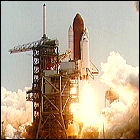 Space Shuttle Columbia lifts off for the fourth and final shuttle “test flight” before NASA’s Space Transportation System is declared fully operational. Remaining in orbit for a full week, Commander Ken Mattingly and Pilot Henry Hartsfield deliver the shuttle program’s first payload for the Department of Defense, as well as some of the first student-submitted experiment packages flown in the shuttle program. Both of Columbia’s solid rocket boosters, which are considered a reusable part of the launch vehicle, are lost at sea when their parachutes fail to deploy after separation and the boosters slam into the Atlantic Ocean; neither of the rockets are able to be recovered.
Space Shuttle Columbia lifts off for the fourth and final shuttle “test flight” before NASA’s Space Transportation System is declared fully operational. Remaining in orbit for a full week, Commander Ken Mattingly and Pilot Henry Hartsfield deliver the shuttle program’s first payload for the Department of Defense, as well as some of the first student-submitted experiment packages flown in the shuttle program. Both of Columbia’s solid rocket boosters, which are considered a reusable part of the launch vehicle, are lost at sea when their parachutes fail to deploy after separation and the boosters slam into the Atlantic Ocean; neither of the rockets are able to be recovered.
STS-3
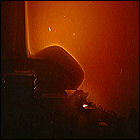 The testing phase of the shuttle program continues as Space Shuttle Columbia lifts off for her third flight into space. With Commander Jack Lousma and Pilot C. Gordon Fullerton aboard, Columbia stays in orbit for over a week, testing the orbiter’s endurance to heat at different angles to the sun, as well as testing the unmanned Spacelab experiment pallets in the cargo bay. This is the first shuttle flight to end on the contingency landing site at White Sands, New Mexico.
The testing phase of the shuttle program continues as Space Shuttle Columbia lifts off for her third flight into space. With Commander Jack Lousma and Pilot C. Gordon Fullerton aboard, Columbia stays in orbit for over a week, testing the orbiter’s endurance to heat at different angles to the sun, as well as testing the unmanned Spacelab experiment pallets in the cargo bay. This is the first shuttle flight to end on the contingency landing site at White Sands, New Mexico.
Columbia takes up arm
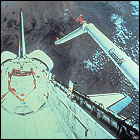 Key to NASA’s claim that the Space Shuttle will be able to deploy, retrieve and repair satellites is the Canadian-built remote manipulator arm system (or “Canadarm”), a project first contracted in 1975 and making its first appearance on Columbia‘s second flight. During tests, the arm performs exactly as expected, and proves to be absolutely vital to many future shuttle missions. The Canadian Space Agency and its subcontractors quickly receive further orders – a Canadarm for every shuttle in the fleet. Fuel cell problems shorten Columbia’s mission from five days to two days, but the crew still accomplishes most of the planned objectives and experiments.
Key to NASA’s claim that the Space Shuttle will be able to deploy, retrieve and repair satellites is the Canadian-built remote manipulator arm system (or “Canadarm”), a project first contracted in 1975 and making its first appearance on Columbia‘s second flight. During tests, the arm performs exactly as expected, and proves to be absolutely vital to many future shuttle missions. The Canadian Space Agency and its subcontractors quickly receive further orders – a Canadarm for every shuttle in the fleet. Fuel cell problems shorten Columbia’s mission from five days to two days, but the crew still accomplishes most of the planned objectives and experiments.
STS-2: Columbia rides again
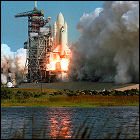 For the first time in history, a space vehicle returns to space for a second complete mission. Space Shuttle Columbia lifts off on its second test flight, with another two-man crew consisting of Joe Engle and Richard Truly, the first all-rookie American space crew since the last Skylab flight. Refinements to various systems are to be tested on this mission, as well as the first use of the remote manipulator arm, upon which nearly all claims of the shuttle’s ability to deploy, retrieve and repair satellites rest.
For the first time in history, a space vehicle returns to space for a second complete mission. Space Shuttle Columbia lifts off on its second test flight, with another two-man crew consisting of Joe Engle and Richard Truly, the first all-rookie American space crew since the last Skylab flight. Refinements to various systems are to be tested on this mission, as well as the first use of the remote manipulator arm, upon which nearly all claims of the shuttle’s ability to deploy, retrieve and repair satellites rest.